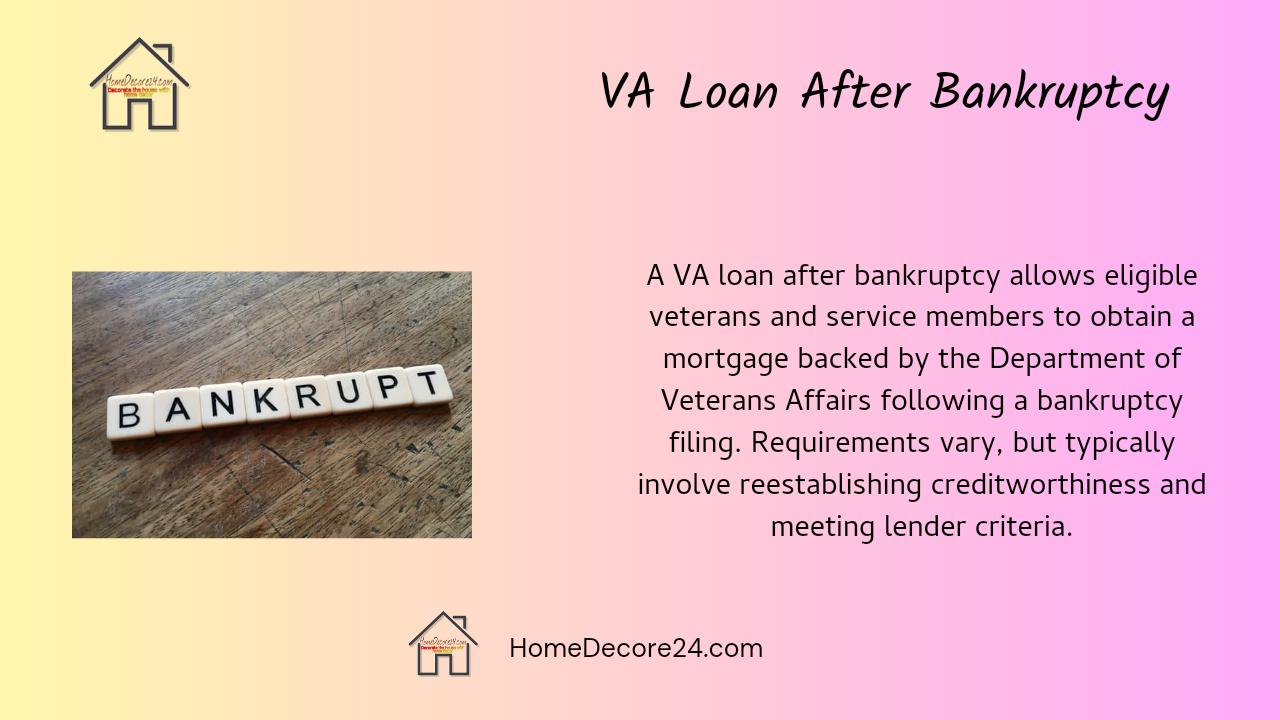
The dream of homeownership remains steadfast even in the face of financial challenges. Bankruptcy, a tough financial hurdle, doesn’t have to be the end of the road for those aspiring to own a home using a VA loan. The U.S. Department of Veterans Affairs (VA) offers a lifeline to eligible veterans, active-duty service members, and select members of the National Guard and Reserves who have faced bankruptcy. This article explores the steps individuals can take to rebuild their financial standing and qualify for a VA loan after bankruptcy. By understanding the process and requirements, hopeful homeowners can embark on a journey of recovery and fulfillment.
A VA loan after bankruptcy allows eligible veterans and service members to obtain a mortgage backed by the Department of Veterans Affairs following a bankruptcy filing. Requirements vary, but typically involve reestablishing creditworthiness and meeting lender criteria.
Can you get a VA home loan after bankrupty?
Yes, you can qualify for a VA home loan after bankruptcy. Meeting specific waiting period requirements and demonstrating responsible financial behavior post-bankruptcy are key factors in eligibility determination.
Read More: Conforming loan limits in 2023 Quick Guide
The VA loan bankruptcy waiting period explained
The VA loan bankruptcy waiting period delineates the time frame individuals must wait after bankruptcy before being eligible for a VA home loan. Chapter 7 bankruptcies generally entail a two-year waiting period, while Chapter 13 bankruptcies can require a waiting period of just one year, provided the borrower has made satisfactory payments and received court approval. This waiting period aims to ensure borrowers have demonstrated financial responsibility and stability before embarking on homeownership through a VA loan.
How to qualify for a Va loan after bankrupty?
Qualifying for a VA loan after bankruptcy involves several steps. First, adhere to the waiting period set by the type of bankruptcy – typically two years for Chapter 7 and one year for Chapter 13, with court approval. Second, rebuild credit by timely payments, reducing debt, and avoiding new debt. Third, maintain a stable income and work towards a good debt-to-income ratio. Lastly, provide a Certificate of Eligibility (COE) and fulfill lender-specific requirements. This process showcases financial responsibility, increasing the likelihood of VA loan approval post-bankruptcy.
How to increase your chance of approval during your bankrupty waiting period
Boosting your approval chances during the bankruptcy waiting period involves strategic steps. First, focus on credit repair: monitor your credit reports for errors, dispute inaccuracies, and consider secured credit cards to rebuild credit. Second, create a budget that emphasizes timely bill payments, helping establish a positive payment history. Third, avoid incurring new debts, prioritizing responsible financial behavior. Fourth, maintain steady employment and a consistent income, showcasing stability. Lastly, engage with a knowledgeable loan officer who specializes in VA loans to navigate the process effectively. This proactive approach enhances your eligibility for a VA loan post-bankruptcy.
Read More: Exploring FHA Jumbo Loans
FAQ’s
How hard is it get a va loan after bankrupty?
Securing a VA loan after bankruptcy can be challenging but not insurmountable. Meeting waiting period requirements, rebuilding credit, and demonstrating financial stability significantly influence approval chances.
How many years after bankrupty can you get a loan?
The waiting period after bankruptcy varies: around 2 years for Chapter 7 and 1 year for Chapter 13 with court approval, to qualify for a VA loan.
YouTube Video
Shortly Key Points
Certainly, here are the key points to consider when seeking a VA loan after bankruptcy:
- Waiting Period: Wait for around 2 years after Chapter 7 bankruptcy or 1 year after Chapter 13 with court approval.
- Credit Repair: Focus on rebuilding credit by checking for errors, disputing inaccuracies, and using secured credit cards.
- Responsible Financial Behavior: Prioritize timely bill payments, avoid accumulating new debts, and demonstrate improved financial habits.
- Stable Income: Maintain steady employment and consistent income to showcase financial stability.
- Debt-to-Income Ratio: Work towards a favorable debt-to-income ratio by reducing debt and managing expenses.
- Certificate of Eligibility: Obtain a Certificate of Eligibility (COE) from the VA to demonstrate eligibility for the loan.
- Expert Guidance: Seek advice from loan officers experienced with VA loans, who can guide you through the process effectively.
Adhering to these points enhances your chances of qualifying for a VA loan post-bankruptcy.
Bottom Line
Emerging from bankruptcy and regaining financial stability can seem like an uphill battle, but for veterans and service members, the VA loan option provides a ray of hope. As this article has illuminated, the road to securing a VA loan after bankruptcy demands patience, discipline, and adherence to specific guidelines.
By diligently working on credit improvement, re-establishing a positive financial track record, and meeting the VA’s waiting period requirements, individuals can inch closer to their homeownership goals. The pride of owning a home, coupled with the support of the VA, can mark a new chapter of achievement and stability, proving that even after facing financial setbacks, the possibility of owning a home remains within reach.






